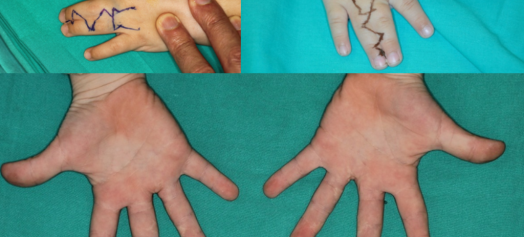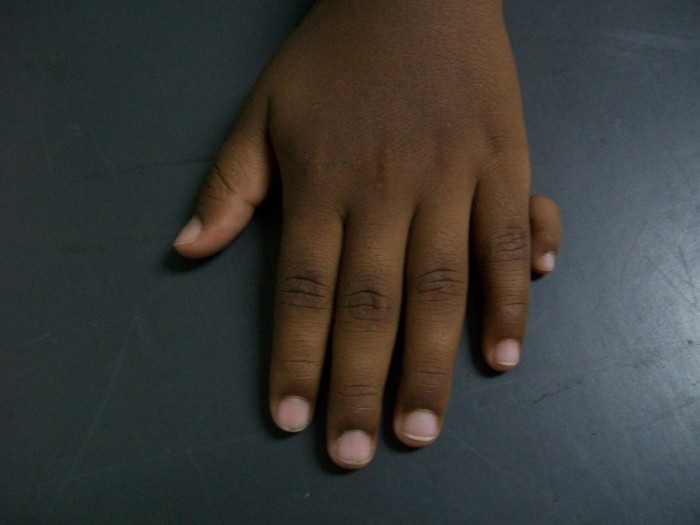Under the label of congenital malformation of the hand we find different pathologies, or combinations thereof, which are characterized by their functional and aesthetic impact on the upper extremity of the newborn: syndactyly, polydactyly or aplasia in the fingers, among them. hand malformations
Also, these malformations of the hand have very different levels of severity -even within the same disease- which means that both their surgery and their prognosis vary greatly depending on the cases.

However, there are at least two common factors to be taken into account by the parents of the affected children. First, the need for an early treatment that can be placed, generically, between one and a half years and two years of age; second, to be aware that the problem of their children is approachable, but through a combination of surgical techniques -plastic, reconstructive or even transference of toes-which requires ‘expert hands’.
We treat this complex issue, precisely, with Dr Piñal, considered one of the world’s best hand surgeons.
Dr, the field of the congenital hand is very broad, could you establish a first classification that will help us to orient ourselves?
Yes of course. The congenital malformations in the hands are of different types, as you say, but they can be grouped into two major categories: failure of differentiation or duplication and formation failures, the former being the most frequent.
Let’s begin then by the malformations of differentiation and their more usual pathologies (…).
Within this type of anomalies or differences the one with the highest incidence is sindactyly, in its multiple variants. Patients with this pathology are born with two or more fingers of the hand ‘stuck’, usually the third and fourth, that is, middle and ring.
It is also a much more frequent situation than it might seem. Its prevalence is one affected by every two thousand births.
How do you approach a case of syndactyly?, Dr
As in the rest of the congenital problems of the hand, it depends on the degree of complexity with which it manifests itself. We are talking about a procedure that involves combining several surgical techniques.
I will make a general clinical note to contextualize. The fusion of two or more fingers implies missing parts, that is, some elements that from an anatomical-physiological point of view should be present in that part of the hand and are not.
Depending on the severity of the syndactyly, we can face from the lack of skin and other soft tissues to anomalies derived from the fusion of blood vessels, bones, tendons, etc.


As in any congenital variable, be it differentiation or formation, we are before a double challenge: functional and aesthetic. So, in essence, an intervention of these characteristics may require the sum of traumatological microsurgery techniques and plastic surgery, for example; something transferable to other birth differences such as polydactyly.
Which are the characteristic features of polydactyly?
Simplifying we go from a pathology that involves missing elements to another characterized by the ‘surplus’. Broadly speaking, polydactyly means being born with more than five fingers in each hand.
In their forms of manifestation there is a significant racial factor. Thus, while in the black people polydactyly of the pinky or postaxial is more common, in the white it is the polydactyly of the thumb or preaxial polydactyly. This, given the role of the thumb in our ability to make a pincer, is the one that supposes a greater functional problem for patients.

Because of that and its aesthetic impact – duplicate thumbs from the root, parts not fully formed, ‘zigzags’, etc. – generates a lot of alarm in families, who usually go quickly to specialists with a proven track record.
Surgical solutions?
The combination of techniques we mentioned before is fundamental again. Depending on the scope and characteristics of the case, roughly speaking, we can try to make two fingers one or eliminate ‘the bad’ and stay with ‘the good’.
In this congenital malformation there is a dominant finger, and in certain cases it is possible to turn it into a ‘superdominant’, that is, to transform it into a thumb that is close to normal in functional and aesthetic terms.
Once again, in what is a constant in this type of pathologies, the prognosis is always better when we have extra elements than when we are missing.
As we’re presenting the congenital differences of the hand bring together diverse pathologies or combinations of them characterized by the functional and aesthetic impact on the newborn, as well as in their later life if they are not addressed.
Dr Piñal and his surgical unit have successfully faced numerous cases of this profile, through a combination of microsurgery techniques, orthopedic surgery and plastic surgery. Thus, the Spanish surgeon analyzes in this new video (06/27/18) – through real cases – pathologies such as syndactyly, duplication of the thumb, the cleft hand or simbrachydactyly at its different levels, from the short fingers syndrome (brachydactily) to the lack of them.
 es
es en
en fr
fr it
it ru
ru zh-hans
zh-hans
